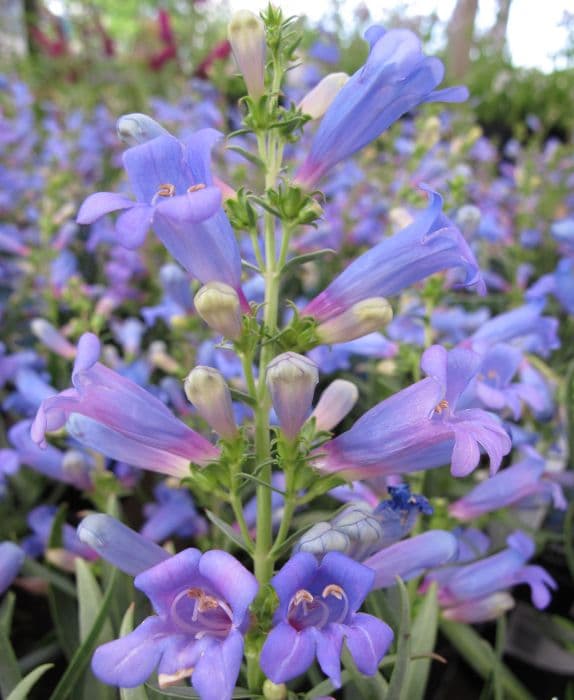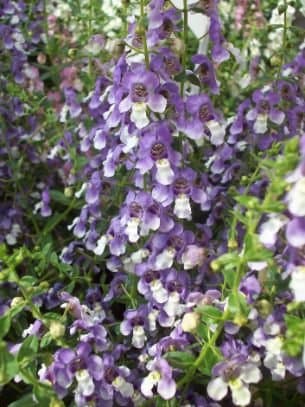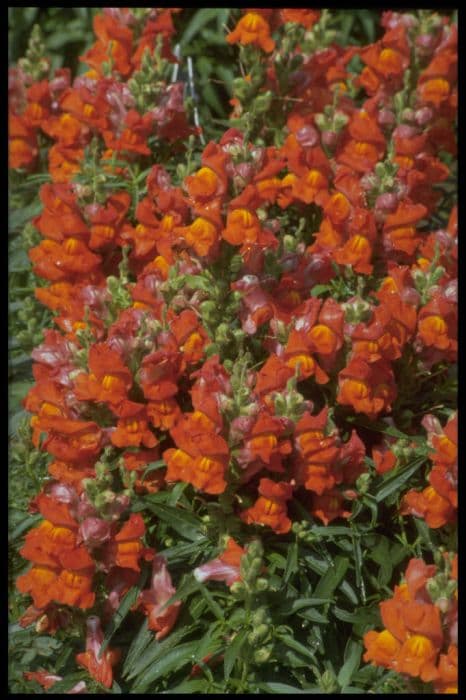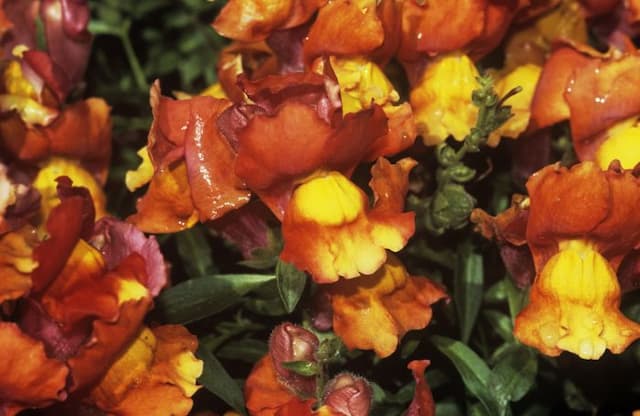Penstemon 'Blue Spring' Penstemon heterophyllus 'Blue Spring'

ABOUT
'Blue Spring' is an evergreen, woody-basedperennial to 45cm tall with narrow, bluish-green, glossy leaves. In summer, it produces dense flower spikes bearing sky-blue funnel-shaped flowers with purple-tinged throats
About this plant
 Names
NamesFamily
Plantaginaceae
Synonyms
Foothill Penstemon, Blue Spring Penstemon, Foothill Beardtongue, Blue Spring Beardtongue
Common names
Penstemon heterophyllus 'Blue Spring'.
 Characteristics
CharacteristicsLife cycle
Perennials
Foliage type
Evergreen
Color of leaves
Green
Flower color
Blue
Height
1-2 feet (30-60 cm)
Spread
1-2 feet (30-60 cm)
Plant type
Herb
Hardiness zones
7-9
Native area
California
Benefits
 General Benefits
General Benefits- Attracts Pollinators: The plant is known to attract bees, butterflies, and other beneficial insects, which helps in the pollination of nearby plants.
- Drought Tolerance: Once established, Penstemon heterophyllus 'Blue Spring' is highly resistant to drought, making it a good choice for water-wise gardens.
- Low Maintenance: It is generally easy to care for and does not require frequent watering or fertilizing.
- Aesthetic Appeal: With its vibrant blue to purple flowers, it adds a splash of color to gardens and landscapes.
- Adaptable: It can thrive in a variety of soil conditions as long as the soil is well-draining.
- Long Blooming Period: It has a long flowering season, usually from late spring to early summer, providing extended visual interest.
- Native Plant Benefits: As a plant native to certain regions, it can help restore natural habitats and support local ecosystems.
- Resistance to Pests: It's generally resistant to pests and diseases, reducing the need for chemical treatments.
- Erosion Control: The plant's root system can help stabilize soil and prevent erosion on slopes.
- Suitable for Xeriscaping: Its drought resistance makes it ideal for xeriscaping, a landscaping method focused on water conservation.
 Medical Properties
Medical PropertiesThis plant is not used for medical purposes.
 Air-purifying Qualities
Air-purifying QualitiesThis plant is not specifically known for air purifying qualities.
 Other Uses
Other Uses- Watercolor Dye: The flowers of Penstemon can be used to create a natural dye for watercolor painting, providing a range of blue and violet hues.
- Garden Photography: Because of its vibrant colors, Penstemon is often used as a subject in garden and plant photography.
- Educational Tool: Penstemon plants can be used in educational settings to teach botany and the importance of pollinators such as bees and hummingbirds.
- Pressing and Scrapbooking: The flowers and leaves of Penstemon can be pressed and used in scrapbooking or making botanical prints.
- Artistic Inspiration: Penstemon's striking appearance can inspire designs in various forms of art, including textile patterns to fine arts.
- Natural Potpourri: Dried Penstemon flowers can be used in potpourri mixes to add color and a light natural fragrance to a room.
- Floral Arrangements: Fresh or dried Penstemon stems are sometimes used in bouquets or indoor floral arrangements for their elongated shape and color.
- Eco-friendly Confetti: Dried Penstemon petals can be used as biodegradable confetti for outdoor celebrations.
- Live Painting Subjects: Penstemon can be incorporated into live art installations or used as subjects for plein air (outdoor) painting sessions.
- Culinary Decoration: While not commonly used for consumption, the non-toxic flowers can be used as an edible garnish for salads and desserts.
Interesting Facts
 Feng Shui
Feng ShuiPenstemon is not used in Feng Shui practice.
 Zodiac Sign Compitability
Zodiac Sign CompitabilityPenstemon is not used in astrology practice.
 Plant Symbolism
Plant Symbolism- Attraction and Charming Beauty: The bright and vivid colors of the Foothill Penstemon can symbolize allure and captivating beauty, drawing in both admirers and pollinators alike.
- Endurance and Adaptability: As a plant that thrives in tough environments, the Foothill Penstemon represents the ability to withstand challenges and adapt to various conditions.
- Diversity and Variety: With its myriad hybrids and color variations, this plant stands for diversity and a wide range of possibilities, highlighting nature's creativity.
- Health and Vitality: The vigorous growth and lively appearance of the Foothill Penstemon often symbolize good health and abundant vitality.
 Water
WaterThe Foothill Penstemon should be watered deeply to establish a strong root system when first planted, so the soil should be moistened thoroughly. Once established, it typically requires less water and should be ideally given about 1 inch of water weekly. In hot, dry periods, you may need to water twice a week, but always allow the soil to dry out between waterings to prevent root rot. It's important to avoid overhead watering to keep the foliage dry and prevent the spread of disease. A good practice is to check the soil moisture with your finger; if the top inch is dry, it's time to water.
 Light
LightThe Foothill Penstemon thrives in full sun conditions, where it can receive at least 6 to 8 hours of direct sunlight daily. It is best placed in a spot where morning sun is prominent as this can ensure vibrant flower production. Partial shade is tolerable, especially in the hottest parts of the day, but full sun is ideal for strongest growth and flowering.
 Temperature
TemperatureThe Foothill Penstemon is hardy in a wide range of temperatures but tends to perform best in areas where daytime temperatures are between 60°F and 75°F. The plant can tolerate temperatures down to about 20°F, making it suitable for gardeners in cooler climates, while maximum temperature tolerance is typically around 90°F without additional stress such as drought or high humidity.
 Pruning
PruningFoothill Penstemon benefits from pruning to shape the plant, encourage bushier growth, and stimulate more blooms. Prune in early spring to remove any dead or damaged stems and again after the first flush of flowers has faded to promote a second bloom. Regular deadheading throughout the blooming season will also help to maintain a tidy appearance and encourage more flowers.
 Cleaning
CleaningAs needed
 Soil
SoilFoothill Penstemon thrives in well-drained soil with low fertility. The best mix is a combination of sandy or loamy soil with some organic matter, but overall very little compost, to mimic its native habitat. The ideal soil pH for Foothill Penstemon is slightly acidic to neutral, ranging from about 6.0 to 7.5.
 Repotting
RepottingFoothill Penstemon does not need frequent repotting and prefers to be undisturbed. Repot the plant every 2-3 years to refresh the soil or when it has outgrown its current container.
 Humidity & Misting
Humidity & MistingFoothill Penstemon is tolerant of a range of humidity conditions and does well in moderately dry environments. It does not require high humidity and is well-suited to the typical atmospheric humidity found outdoors in its native range.
 Suitable locations
Suitable locationsIndoor
Ensure bright light, minimal watering, and good air flow.
Outdoor
Place in full sun, protect from extreme cold.
Hardiness zone
6-9 USDA
 Life cycle
Life cyclePenstemon heterophyllus 'Blue Spring', commonly known as Foothill Penstemon, begins its life cycle as a seed which, when conditions are right, germinates in the soil. Once germinated, the young seedling emerges and establishes its root system while developing its first true leaves. As a perennial, it then enters a phase of vegetative growth, producing a rosette of leaves and stems that continue to grow and mature. Following this, the Foothill Penstemon enters the flowering stage typically in late spring or early summer, showcasing vibrant blue to violet blossoms that attract pollinators such as bees and hummingbirds. After pollination occurs, the plant produces fruit in the form of capsules containing seeds, completing the reproductive cycle. With the arrival of cooler temperatures or adverse conditions, the plant may die back above ground, but the root system remains alive, allowing the Foothill Penstemon to regrow and repeat its life cycle in the following season.
 Propogation
PropogationPropogation time
Spring-Early Summer
Propogation: The most popular method of propagation for Penstemon heterophyllus 'Blue Spring', commonly known as Foothill Penstemon, is through softwood cuttings. This is best done in late spring or early summer when the plant's new growth is just beginning to harden (semi-ripe). To propagate, cut a length of stem about 3 to 5 inches long, making sure at least a couple of leaf nodes are present. Remove the bottom leaves and dip the cut end into a rooting hormone powder to encourage root development. The cutting should then be planted in a well-draining soil mix, kept moist, and covered with a plastic bag or placed in a greenhouse to maintain humidity. Roots typically form within a few weeks, after which the new plant can be gradually acclimated to less humid conditions and eventually planted out.









